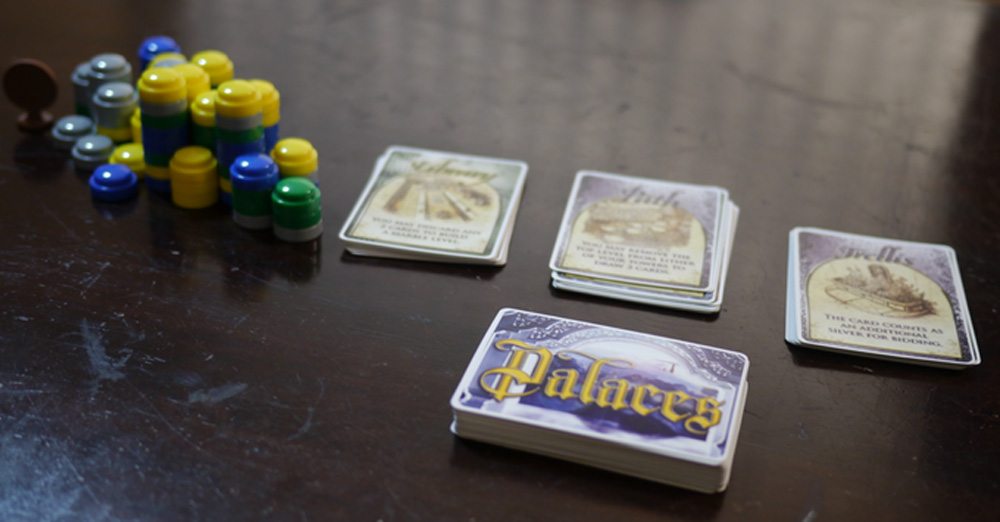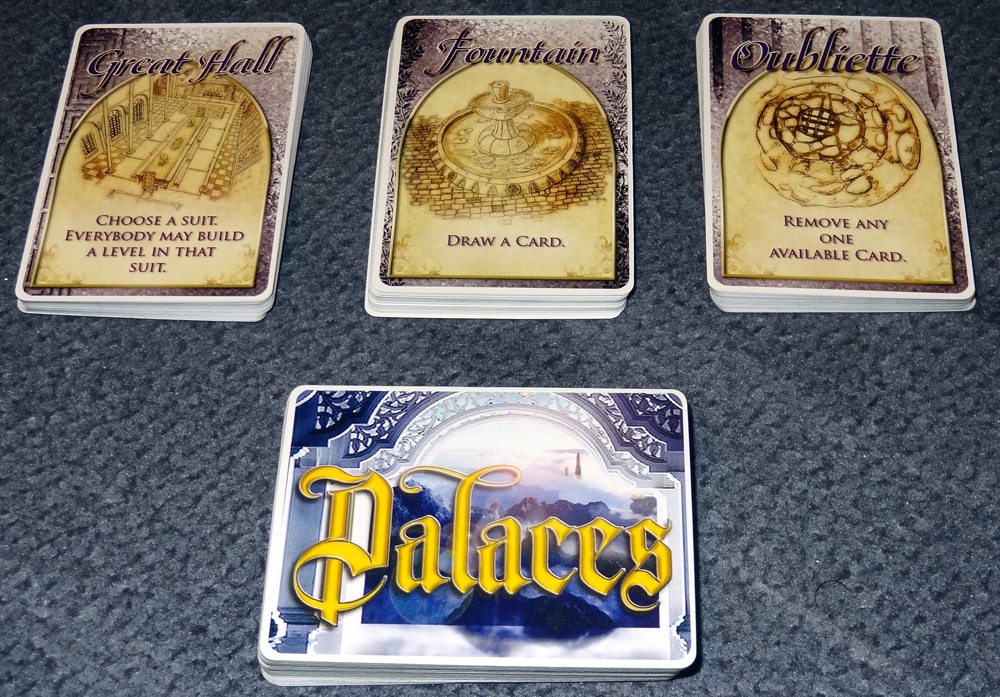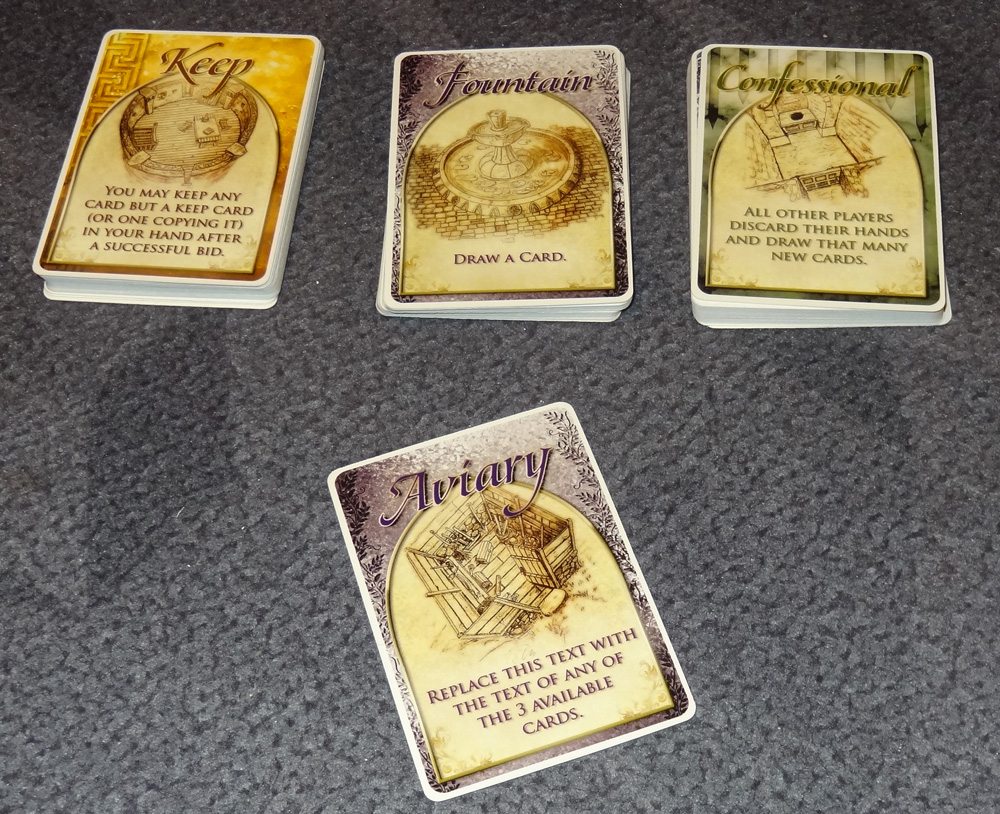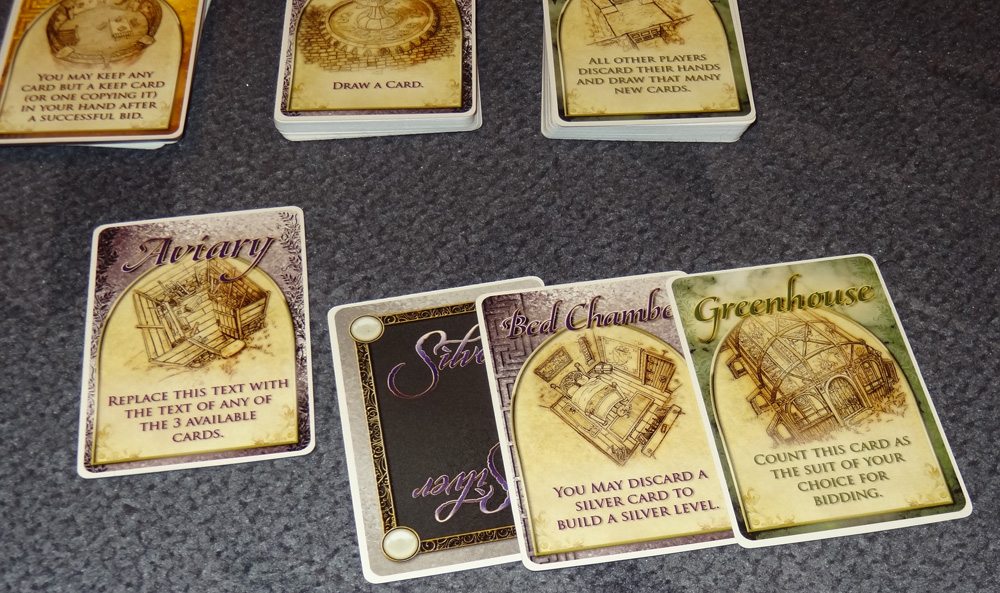In Palaces, you and your opponents compete to build the most luxurious palaces. Bid on precious materials to build up your towers–but you’ll have to make them match!
At a glance: Palaces is a deck-building game by Jeff Siadek for 2 to 4 players, ages 12 and up, and takes about an hour to play. It’s currently seeking funding on Kickstarter, with a $25 pledge for a copy of the game. I think you could go younger, maybe 8 or 10, as long as your kids have some familiarity with deck-building and can manage interactions between card abilities.
New to Kickstarter? Check out our crowdfunding primer.

Components
I had a prototype copy of Palaces for review purposes, so it did not have final component quality, although the artwork is “nearly final,” according to the publisher.
The final game will include:
- 24 Castle cards
- 24 Garden cards
- 24 Dungeon cards
- 48 Basic Resource cards
- 100 plastic tower pieces (25 each Gold, Silver, Crystal, Jade)
- Active player marker

The Basic Resource cards are the starting cards, made of the four material types: Gold, Silver, Crystal, and Jade. The Castle, Garden, and Dungeon cards also come in these four material types, but they also represent different “rooms” that have special abilities when played.

The starting cards just have the material names on them and are also distinguished by color. The room cards have different backgrounds to represent the Castle, Garden, and Dungeon. The materials of room cards are only indicated by the color of the card–I’ve recommended to the designer that it may be helpful to have an icon or text in addition, for color-blind players or to help in situations when you don’t have great lighting. Each room card also has a name, a small illustration, and a text description of the card’s ability. The artwork is fine but isn’t particularly exciting to me.
The tower pieces seen in the Kickstarter video are plastic domes with a lip, made so that they stack well, and there’s a stretch goal to upgrade the material so they have a marbleized appearance. The prototype did not have tower pieces, so we used poker chips (from Pandante) for the tower pieces.

How to Play
You can download the latest version of the rules here, and there is also a Print and Play version available in case you’d like to give it a try yourself.
The goal of the game is to have the most valuable towers when the game ends. Each player will build two towers, and only the lower of the two towers will count.
To set up, give each player a starting deck made of 3 of each Basic Resource. This is a deck-building game, so each player will have a deck, hand, and discard pile, separate from the common decks. Shuffle your starting deck and draw a hand of 4 cards.
Each of the three room decks–Castle, Garden, and Dungeon–are shuffled separately, and 12 cards of each are removed at random. Place the three decks in the center of the play area, with the top card of each turned face up. These three cards are the “available” cards. Choose somebody to start and give them the active player marker. Generally, the Castle cards help you build your palace, Garden cards help you build your deck, and Dungeon cards let you interfere with other players.

When you are the active player, you pick a prize card–choose one of the three available cards to auction and place it in the center of the table, and then turn over the next card from that deck. Players will now bid on the prize card, starting with the player to your left (so you get the last bid when you’re the active player).
Each player gets one bid, made of some number of materials. The largest set of one type wins the bid, so 3 Jade will beat 2 of anything. If the size of the set matches, then the most valuable resource wins (2 Gold beats 2 Crystal). If the size and type match, then the next largest set is considered (3 Jade + 1 Gold beats 3 Jade + 1 Crystal). One other note: the Prize card itself can be counted as part of your bid, and the winner of the auction will get to use the Prize card’s ability immediately.
You may bluff during your bid to drive up the price–however, if you win the auction and are unable to pay your bid, you must discard a card and then the bidding restarts. If everyone passes because nobody wants the card, the prize card is removed from the game and the active player token is passed to the next player.
If you didn’t win the auction, you get to draw cards–1 if the prize card was Crystal or Jade, and 2 if the prize card was Gold or Silver.

If you win the auction, you reveal the cards you’re using to pay for your bid. Any special abilities on the cards in your bid (including the prize card) may be activated in the order of your choice. Put all of the cards you spent, along with the prize card, into your own discard pile. You do not draw cards if you won, and you don’t discard any cards that were not spent in the bid or due to special abilities. Then, you get to build one of your towers, in the resource matching the prize card.

When building, your two towers must match each other level by level. So if you start with Silver as the base of the first tower, your second tower must also start with Silver. Once you’ve started building, you always have to match the taller tower, or else build on top of the taller tower. Some room abilities let you build additional rooms–these builds and the build from your prize card can be taken in any order, as long as each build is legal.
Finally, the active player token is passed to the next player and a new round begins.
The game ends at the end of a round when one of the room decks is empty, or when a type of tower piece runs out. Compare everyone’s lower tower–the tallest tower wins. In case of a tie, compare the suits, and then the next highest level, and so on.

The Verdict
It’s no secret that I like deck-building games–I love seeing how deck-building is incorporated into games, and I particularly enjoy when game designers find new ways to use it. And I’ve also been a fan of some of Jeff Siadek’s other games, including The Worst Game Ever. So I was curious to see his take on the genre. Palaces definitely feels like a new way to use deck-building, both because of the tower-building aspect but also because of the way that cards are acquired and used.
The bidding process for acquiring cards definitely adds a lot more interactivity to a part of deck-building that can sometimes feel like solitaire. Even the choice of which card to put up for auction is important: do you pick a material that you know none of your opponents really wants because it doesn’t match their other towers? Do you pick a Gold or Silver card, knowing that you can’t win, because then at least you’ll get to draw 2 cards instead of 1?

Since your card powers activate only when you spend them, choosing your bid carefully is important, too. Sometimes you’ll throw in a few other cards to a bid, not really to drive up the price, but just so you’ll be able to play those abilities. Of course, if your abilities require discarding cards from your hand in order to activate them, you’ll need to make sure you save a few cards for that.
In Palaces, every card also functions as currency: the material of the card can be used later to bid on other cards. The more cards you have of the same suit, the stronger your bid–so then you have to decide whether to diversify and buy cards of different suits, or try to acquire a lot of the same suit so you can win more bids. The only problem there is that you’re never guaranteed that your desired suit will come up for auction.

There are a lot of great card abilities, too. Some cards allow you to copy the text of other cards, which can be very useful if you’ve got good cards to copy. Others give you more control over what to build, helping you match your towers so you can build more effectively.
Using your lower tower as a score isn’t an entirely new trick–it reminds me most recently of Between Two Cities–but it’s a good one. It forces you to build both towers and to focus on the one that’s behind. But it can also mean that you don’t want to build too high on the other tower because that forces you into particular materials for future builds. Ideally, you want both of your towers growing at the same pace, so that every other turn you aren’t limited by what you can buy. In reality, though, you’ll often have to make do, building on top of your tall tower simply because it’s the only thing you can do.
Overall, I enjoyed Palaces. The art and design on it isn’t spectacular, but the gameplay is nice and allows for a lot of player interaction. I also like the way that it’s possible to catch up even when it looks like somebody has an early lead, because of the way that you’re limited in what you can build. If you like deck-building games and you want to see a new twist on it, head on over to the Palaces Kickstarter page for more!






Spread the word